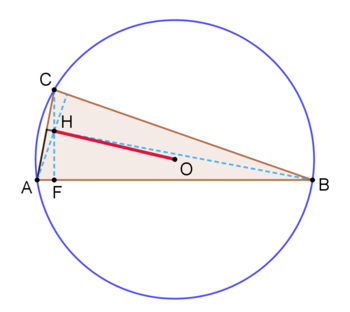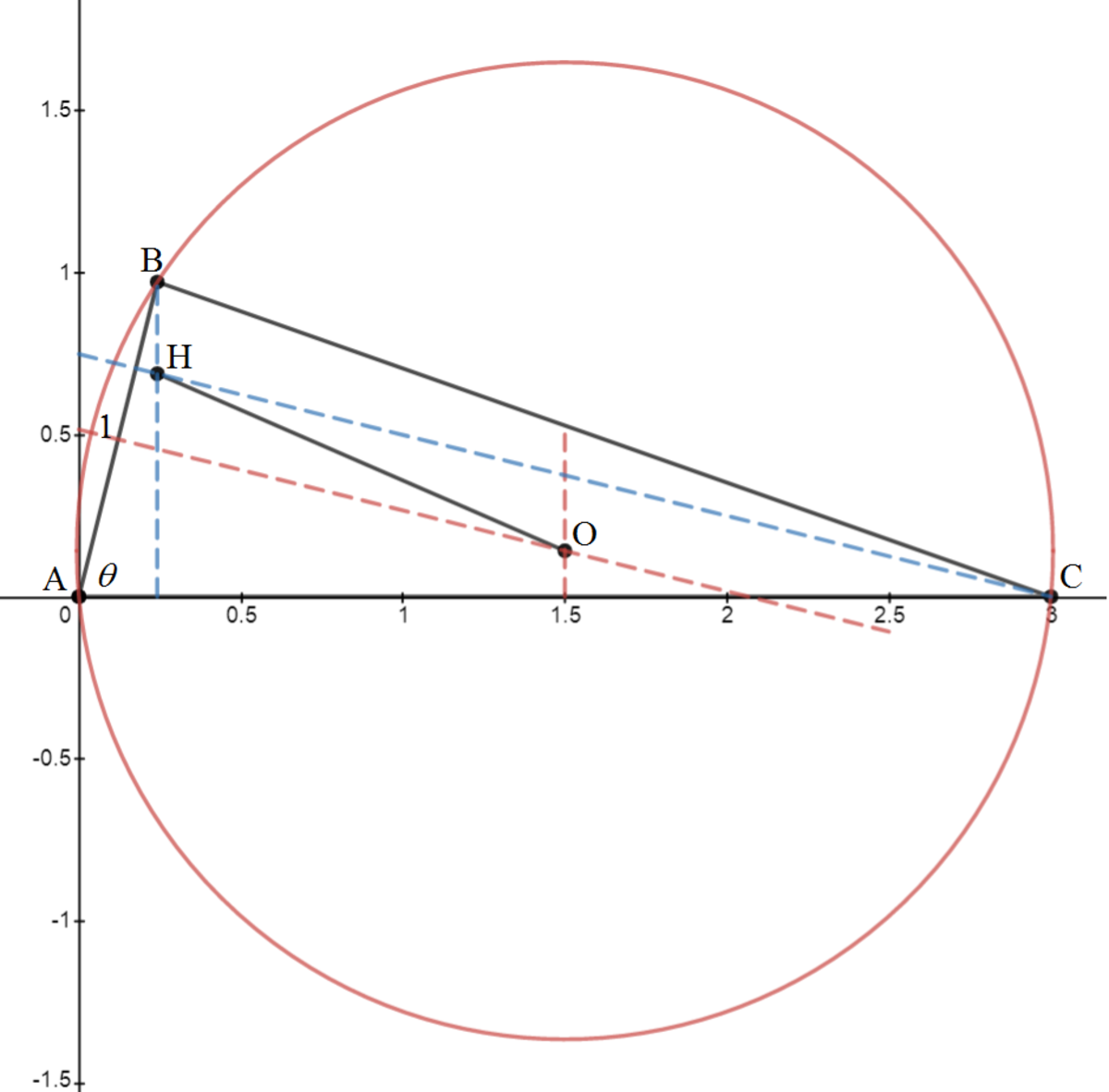Can You Minimize This?
The lengths of two sides of a triangle are 1 and 3. What is the smallest possible distance, d , between the orthocenter and circumcenter of such a triangle? Submit ⌊ 1 0 5 d ⌋ .
The answer is 134956.
This section requires Javascript.
You are seeing this because something didn't load right. We suggest you, (a) try
refreshing the page, (b) enabling javascript if it is disabled on your browser and,
finally, (c)
loading the
non-javascript version of this page
. We're sorry about the hassle.
3 solutions
 This is the triangle with HO minimised
This is the triangle with HO minimised
A convenient formula for the distance d between the orthocentre H and the circumcenter O of a triangle is
H O = 4 Δ a 6 − b 2 a 4 − c 2 a 4 − b 4 a 2 − c 4 a 2 + 3 b 2 c 2 + b 6 − b 2 c 4 − b 4 c 2 where a , b and c are the side lengths of the triangle and Δ is its area. This formula can be found here .
Let a = 1 and b = 3 . Then combined with Heron's formula for the area, the above formula gives d = H O = − c 4 + 2 0 c 2 − 6 4 c 6 − 1 0 c 4 − 5 5 c 2 + 6 4 0 Minimising d is equivalent to minimising d 2 i.e. we are looking for the minimum of the function f ( c ) = − c 4 + 2 0 c 2 − 6 4 c c 6 − 1 0 c 4 − 5 5 c 2 + 6 4 0 , where c ∈ ( 2 , 4 ) (a restriction imposed by the triangle inequality).
Taking the derivative,
f ′ ( c ) = − ( − c 4 + 2 0 c 2 − 6 4 c ) 2 2 c ( c 8 − 4 0 c 6 + 4 4 7 c 4 − 2 5 6 0 c 2 + 9 2 8 0 )
At the critical point
f ′ ( c ) = 0 ⇔ c = 0 c 8 − 4 0 c 6 + 4 4 7 c 4 − 2 5 6 0 c 2 + 9 2 8 0 = 0 ⇔ ( c 4 − 3 5 c 2 + 2 3 2 ) ( c 4 − 5 c 2 + 4 0 ) = 0 ⇔ c 4 − 3 5 c 2 + 2 3 2 = 0 ⇔ 2 < c < 4 c = 2 3 5 − 3 3 3
At this point, the second derivative is positive, ensuring that we have a minimum, which is f ⎝ ⎛ 2 3 5 − 3 3 3 ⎠ ⎞ = 8 3 3 3 3 − 1 7 5 Hence, the smallest possible distance between the orthocenter and circumcenter of our triangle is d = 8 3 3 3 3 − 1 7 5 ≈ 1 . 3 4 9 5 6 3 2 3 1 9 For the answer, ⌊ 1 0 5 d ⌋ = 1 3 4 9 5 6 .

Label the triangle A B C such that A B = 1 and A C = 3 . Let A ( 0 , 0 ) and ∠ A = θ . Then B ( cos θ , sin θ ) and C ( 3 , 0 ) . And the circumcenter O ( x O , y O ) is the intersecting point of perpendicular bisectors of A B and A C . Therefore x O = 2 3 and
x O − 2 1 cos θ y O − 2 1 sin θ = − cot θ ⟹ y O = 2 sin θ − ( 3 − cos θ ) cot θ
Then the circumcenter is O ( 2 3 , 2 sin θ − ( 3 − cos θ ) cot θ )
The orthocenter H ( x H , y H ) is the intersecting point of the altitudes from A and C . Then x H = cos θ and
x H − 3 y H = − cot θ ⟹ y H = ( 3 − cos θ ) cot θ
Then the orthocenter is H ( cos θ , ( 3 − cos θ ) cot θ ) .
Therefore O H = ( 2 3 − cos θ ) 2 + ( 2 sin θ − 3 ( 3 − cos θ ) cot θ ) 2 . Finding the minimum of O H numerically, we have d ≈ 1 . 3 4 9 5 6 3 2 3 2 ⟹ ⌊ 1 0 5 d ⌋ = 1 3 4 9 5 6 .
How did you get the formulae for O and H ?
Log in to reply
I have redone the solution.
Log in to reply
Trigonometry is a power tool in your hands. Thank you for explaining it. Well done!
The formula for the distance in question, d can be found here . That is, for triangle with side lengths a , b , c and angles A , B , C , respectively, we want to minimize ( 4 sin 2 C 9 c 2 − ( a 2 + b 2 + c 2 ) ) 1 / 2 which is the same thing as minimizing the square of the distance, D : = 4 sin 2 C 9 c 2 − ( a 2 + b 2 + c 2 ) . Without the loss of generality, let a = 1 , b = 3 and c denote the unknown side length. By triangle inequality , 3 − 1 < c < 3 + 1 or 2 < c < 4 . Thus, we have a single variable function D ( c ) = 4 sin 2 C 9 c 2 − c 2 − 1 0 Using cosine rule , we have c 2 = 1 2 + 3 2 − 2 ⋅ 1 ⋅ 3 ⋅ cos C ⇔ 2 cos C = 3 1 0 − c 2 Since 4 sin 2 C = 4 − 4 cos 2 C , then 4 sin 2 C = 4 − ( 2 cos C ) 2 = 4 − ( 3 1 0 − c 2 ) 2 Substitute the expression into D ( c ) and simplify gives: D ( c ) = − c 4 − 2 0 c 2 + 6 4 8 1 c 2 − c 2 − 1 0 , 2 < c < 4 For simplicity sake, let c 2 = x with 4 < x < 1 6 , we want to minimize f ( x ) 0 : = = − x 2 − 2 0 x + 6 4 8 1 x − x − 1 0 − x − x − 1 6 1 0 8 + x − 4 2 7 − 1 0 , 4 < x < 1 6 At its critical point, f ′ ( x ) = 0 , which is − ( x − 4 ) 2 2 7 + ( x − 1 6 ) 2 1 0 8 − 1 = 0 ⇔ ( x − 1 6 ) 2 ( x − 4 ) 2 ( x 2 − 3 5 x + 2 3 2 ) ( x 2 − 5 x + 4 0 ) = 0 Using the quadratic formula with the constraint 4 < x < 1 6 , we have a critical point x = 2 3 5 − 3 3 3 . Since both x → 4 + lim f ( x ) and x → 1 6 − lim f ( x ) diverge to infinity, this means that f ( x ) have no maximum value, and thus the critical point we've found is a minimum value. Hence, the miminum value of D ( c ) occurs when c = x = 2 3 5 − 3 3 3 , d = min ( D ) = D ⎝ ⎛ 2 3 5 − 3 3 3 ⎠ ⎞ = 8 3 3 3 3 − 1 7 5 ≈ 1 . 3 4 9 5 6 3 2 . The answer is ⌊ 1 0 5 ⋅ 1 . 3 4 9 5 6 3 2 ⌋ = 1 3 4 9 5 6 .